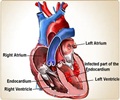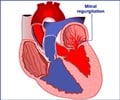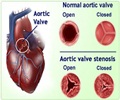- The Bicuspid Aortic Valve - (http://dx.doi.org/10.1016/j.cpcardiol.2005.06.002)
- What is Bicuspid Aortic Valve Disease? - (https://en.wikipedia.org/wiki/bicuspid_aortic_valve)
- Bicuspid aortic valve - (https://medlineplus.gov/ency/article/007325.htm)
- Problem: Aortic Valve Stenosis - (http://www.heart.org/heartorg/conditions/more/heartvalveproblemsanddisease/problem-aortic-valve-stenosis_ucm_450437_article.jsp#.wvffdovoliu)
- Reimplantation Valve Sparing Surgery - (https://my.clevelandclinic.org/health/articles/reimplantation-valve-sparing-surgery)
- About Bicuspid Aortic Valve Disease - (https://www.marfan.org/bicuspid-aortic-valve)
- Bicuspid Aortic Valve Disease - (https://my.clevelandclinic.org/health/articles/bicuspid-aortic-valve-disease)
What is Bicuspid Aortic Valve?
Bicuspid aortic valve (BAV) is a very common congenital cardiac malformation. It afflicts about 1-2% of population with a predominance in males.
The aorta is the main artery arising from the heart that distributes oxygenated blood to the body. The aortic valve is located between the heart and the aorta. It facilitates the flow of blood in one direction from left ventricle to the aorta and prevents the backward flow.
The normal aortic valve has three flexible leaflets or flaps. When the valve closes, the flaps come together and appear as a circle which has been trisected.
In a bicuspid aortic valve, the aortic valve has only two leaflets or flaps. This is because two of the three leaflets fuse during development of the fetus in the womb, resulting in a two-leaflet valve, instead of the normal three-leaflet (tricuspid) valve. Heart defects like ventricular septal defect, coarctation of aorta or anomalies in coronary artery may also be present.
Depending on the extent of the malformation, the blood flowing through the valve may make an abnormal sound, called a murmur. The detection of the murmur could be an indication of the aortic valve abnormality. Two common consequences of a bicuspid aortic valve are:
Bicuspid aortic valve regurgitation (insufficiency):
Heart valve regurgitation means leaking heart valves. In this condition, the defective aortic valve does not close properly and the blood leaks back into the heart. This leakage is referred to as insufficiency or regurgitation. This strains the heart which has to re-pump the blood. This could result in permanent stretching of the fibers in left ventricle and the pumping efficiency of the heart may reduce.
Bicuspid aortic valve stenosis:
At times, the bicuspid aortic valve loses its ability to open widely and has calcium deposits on the flaps. This condition is known as stenosis. Gradually, the opening become narrower and heart is forced to work harder to pump blood. This leads to thickening of the ventricular wall. Stenosis is generally observed in patients older than 20 years of age.
Patients with bicuspid aortic valve are at a higher risk of developing diseases of the aorta which include aortic aneurysm, aortic dissection and aortic coarctation.
What are the Causes of Bicuspid Aortic Valve?
The actual cause of BAV disease is not very clear. However, it is reported that it may be caused by a connective tissue disorder. Scientific reports indicate that the valve deformity develops in the early stages of pregnancy and the abnormality is present at birth. It has been reported that BAV is a hereditary disorder and often runs in families.
What are the Signs and Symptoms of Bicuspid Aortic Valve?
In most patients suffering from BAV, no typical symptoms are seen. The patients may tire easily and have difficulty in completing normal activities, even with mild exertion.
Other symptoms could include:
- Heart murmur
- Chest pain
- Pale skin
- Irregular heart beat
- Difficulty in breathing
- Fainting
- Weak pulse in the wrists and ankles

In some patients, by the time BAV is detected or becomes symptomatic, the heart valve gets severely damaged and patient may experience congestive heart failure or sudden death.
What are the Complications of Bicuspid Aortic Valve?
Bicuspid aortic valve disease may progress or the valves become calcified, which could lead to varying degrees of severity of aortic stenosis or aortic regurgitation, or both. It may eventually require surgical intervention. Some of the other complications are listed below:
Infective endocarditis:
A serious complication of bicuspid valvular disease is infective endocarditis. At times, the patients are not aware of suffering from BAV, until the onset of infective endocarditis. Most of the times, the BAV endocarditis patients are young males.

Thrombus formation:
Thrombus or clot formation is a rare complication of BAV. It could appear following surgery for BAV. The thrombus could separate out result in embolization, stroke or myocardial infarction.
Ascending aortic aneurysm:
Some patients afflicted with bicuspid aortic valve dysfunction may develop aortic aneurysm, which is the widening of the aorta.
Other complications:
The laboratory tests indicate that BAV patients often have high levels of cholesterol and C-reative protein. High levels of cholesterol have been associated with valve calcification.
The obstruction of left ventricular outflow tract due to BAV can also lead to sudden death.
How do you Diagnose Bicuspid Aortic Valve?
Diagnostic tests help in monitoring the status of aorta and aorta valve. Some of the tests which help in diagnosis of BAV include:
- Echocardiograms

- Magnetic resonance imaging of the heart
How do you Treat Bicuspid Aortic Valve?
Treatment with Medications:
In patients where the aorta is enlarged or aortic valve regurgitation is observed, medicines may be required to provide relief from symptoms or prevent complications. These may include:
- Blood pressure medications like ACE inhibitors and beta blockers
- Medications which help heart muscle pump harder like calcium channel blockers and inotropic agents.
Surgical treatment:
The primary treatment for BAV, as a long-term solution, is surgery. The options vary with the condition of aorta and criticality of BAV. Some of the surgical techniques include:
- Valve-sparing technique – This is a surgical treatment for aortic aneurysms, wherein the aneurysm is repaired and at the same time, the patient’s own aortic valve is preserved.
- Aortic valve replacement, which could be with a mechanical valve or a tissue valve.
Aortic balloon valvuloplasty- In simple terms, this is valve repair procedure which is less invasive than open heart surgery. The narrowed valve is dilated with the help of a catheter with a balloon, which is inflated at the site of the valve.

How do you Prevent Bicuspid Aortic Valve?
There is no known way to prevent bicuspid aortic valve. If bicuspid aortic valve runs in the family, the healthcare provider must be consulted before planning a pregnancy.
What Precautions must be Taken by Patients with Bicuspid Aortic Valve?
- Lifestyle changes with respect to diet and exercise must be implemented
- Patients must stop smoking in the form of active or passive smoking
- A regular exercise regimen must be followed
Health tips to avoid, diagnose and control bicuspid aortic valve
- Patients suffering from bicuspid aortic valves are advised preventive antibiotics before any invasive procedure, to prevent the development of infective endocarditis
- Beta- blocker medicines reduce progression of aortic aneurysms
- Blood pressure must be closely monitored and hypertension must be avoided
- Statin medication to reduce cholesterol levels and prevent calcium build-up on aortic valve and reduce risk of aortic stenosis









